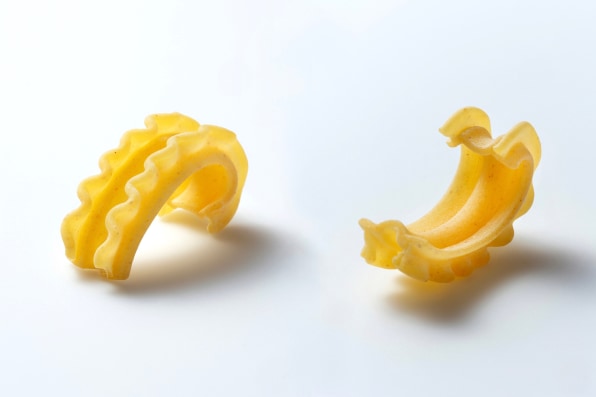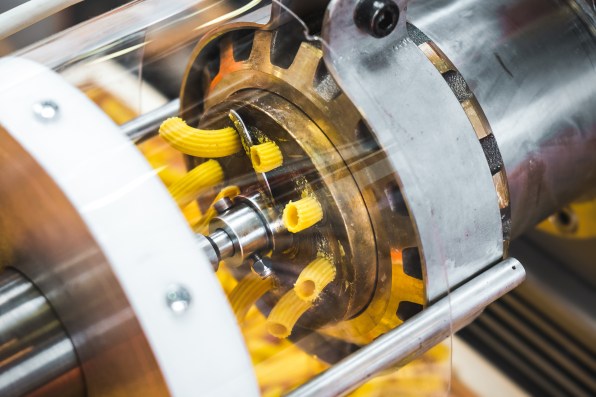Enter cascatelli—which usually means “waterfall” in Italian—the world’s newest pasta condition. Pashman designed the condition to maintain a lot of sauce and be very easily stabbed with a fork. To me, a foods historian and previous bistro chef, it appears to be like the appreciate little one of two lesser-regarded pastas, creste di galle and mafaldine.
When the history of this new form has been closely documented, which include in a 5-part podcast, the tale driving how pasta obtained its form is a bit murkier.

The noodle is born
Pasta is one particular of the oldest processed food items, relationship back again several thousand years to around 1100 BC. For comparison, bread dates back to all around 8000 BC.
Triticum, or durum, wheat essential to make a durable dry pasta is Center Japanese in origin, so it is probable that Arabs and many others in the Center East ended up generating and ingesting the earliest present day varieties of dry pasta—as tiny balls like acini de pepe and couscous—before they became frequent in Italy.
These little varieties of pasta held nicely in very hot climates and could be cooked using very tiny fuel, which was scarce in Arab dominions. Since they were being dehydrated and sturdy, they had been an ideal foods for individuals touring throughout the Center East and northern Africa.
The earliest pasta condition was a easy sheet, which was taken care of extra like bread dough. It likely didn’t have the toothsome excellent (regarded as “al dente”) connected with Italian pasta these days, and would have been related to unleavened matzo bread with sauce on it. The 1st mention of boiled pasta was not right until the fifth century Advert, in the Jerusalem Talmud.
Most of the earliest varieties of pasta that we consider to be the main of the Italian repertoire—such as vermicelli and spaghetti—were being in all probability initially developed by Arabs and didn’t look in Italy until finally the 9th or 10th hundreds of years. These noodles became prevalent at the time durum wheat experienced founded alone in Sicily and regional foods makers learned to perform with the semolina flour it manufactured.
Italy and an explosion of designs
Spaghetti, which implies little strings, was straightforward to make and dry in the climates of Southern Italy.
In Italy, these slender noodles were being at first reduce from sheets utilizing knives or wire cutters. Almost all the earliest designs have been probably shaped by hand, which was a cumbersome approach, so persons labored on building their generation additional successful as pasta acquired worth in their diets.
What actually sparked the explosion of pasta shapes was the invention of the extrusion push. Versions of an extruder had been experimented with because the 1300s, but it took the revolution in mechanics of the Renaissance to make it possible for the machines to promptly mass-develop pasta, like shapes like elbow macaroni, rigatoni, and tagliatelle.
Rigid pasta doughs built from semolina could be worked in huge quantities by devices in volumes not achievable by guide output. These doughs have been then extruded as a result of bronze “dies” that yielded the fashion of pasta common currently. Bronze was challenging enough to be resilient but soft sufficient to be conveniently worked making use of pre-Industrial Revolution technologies.
The introduction of equipment driven by steam in the 1800s through the Industrial Revolution made the method of extruding noodles even far more successful. As manufacturing facility-designed pasta caught on with the general public, manufacturers rapidly additional pastas of a variety of designs and measurements to their repertoire. Fantastic designs like gemmeli, radiatori, wagon wheels, and stuffable shells soon crowded the cabinets.

The united states embraces the noodle
The U.S. was gradual to adopt most of the wide wide variety of pasta shapes common in Italy.
That’s inspite of the simple fact that Founding Father Thomas Jefferson was a key proponent of pasta and even owned a pasta maker at his residence in Monticello.
The earliest Italian immigrants to America arrived from the northern locations of the peninsula, but their in general quantities were tiny. The 1st documented pasta factory in The usa was established in Brooklyn in 1848, and by the time of the Civil War, macaroni, as it was mainly referred to as then, was rather common on American tables. While Italian noodles have been termed macaroni, they ended up most usually some sort of flat noodle, like fettuccine.
American pasta consumption started to surge pursuing the “Great Arrival” of practically 4 million Italian immigrants to the U.S. from 1880 to 1920, most from Southern Italy. This is when most of the pasta dishes Americans are acquainted with right now, these as spaghetti and meatballs, cheesy elbow macaroni, and linguine with clam sauce, grew to become popular.
But it wasn’t until eventually the Italian “food boom” of the 1970s and 1980s that Americans grew to become common with the cornucopia of pasta shapes, sizes, sauces, and fillings that have been typical in Italy.
Right now, Us citizens take into consideration pasta one of their favorite meals, which signifies there is in all probability usually space for a single a lot more variety.